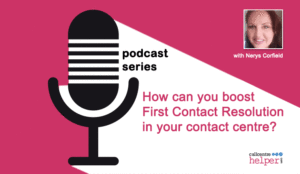First call resolution (FCR) is a well-known contact centre outcome metric.
Odigo’s Stuart Clarke outlines seven ways to increase it with high-quality experiences that focus on customer satisfaction.
Does resolution guarantee customer satisfaction?
No.
For customers who don’t get the outcome or standard of service they expect the experience won’t be a satisfactory one.
That’s why even something as influential as first call resolution shouldn’t be the sole focus of performance or service optimisation.
In fact, no metric should be analysed in isolation. By pairing first call resolution with a quality indicator like customer satisfaction, improvements become more meaningful and a better indicator for successful customer experience (CX) strategies.
So where should organisations focus their efforts to improve first call resolution? Often the best place to start is by tackling what doesn’t work.
First Call Resolution Pitfalls
There are fairly common roadblocks to resolution. Many arise because of a mismatch or misunderstanding between agents and customers during an interaction:
- Intent: trying to resolve the wrong problem leads nowhere.
- Outcome: the query may be resolved from the agent’s point of view but is it actually what the customer wanted?
- Knowledge: proceedings can grind to a halt when any of the following occur
- An agent doesn’t have access to the information they need,
- Experts are unavailable,
- The customer doesn’t understand what an agent is trying to explain,
- Documentation or details are missing.
- Skills: without training, agents may struggle to handle high-complexity and emotionally intense queries. The right soft skills like active listening, critical thinking and clear concise communication have a huge impact on both if and how a query is resolved.
- Time and Effort: if an agent embarks on a process that takes 15 minutes when the customer only has 5 the result can be failure and frustration. Equally, in a technical situation, following an explanation or step-by-step verbal instructions may be beyond the capabilities of some customers.
When these points of friction or misunderstanding arise, a customer’s perception of the experience will be affected, even if first call resolution is achieved.
Equally lengthy calls, multiple hold periods, verifying details, requests for additional information and transfers to other departments may lead to first call resolution but can decrease customer satisfaction and potentially loyalty.
The key to high-quality first call resolution lies in promoting understanding. An agent who knows what a customer wants and the best way to achieve the closest possible result can manage both their expectations and the query itself.
Improving First Call Resolution With High-Quality CX
1. Identify the Issue
Qualification is crucial to avoid misunderstandings. If limited options or poor IVR configuration lead to agents receiving the wrong information it can instantly send interactions in the wrong direction.
Something that can take a fair bit of time to correct or even have an agent operating under a misconception the entire time.
Organisations can catalogue the reasons for customer calls by introducing natural language processing into qualification.
This information can be used to refine qualification, enabling an AI-driven process which allows customers to simply state the nature of their query.
If ID&V is included in qualification, when customers are connected, agents are already prepared with the clarity and context to move directly towards first call resolution.
2. Leverage the Best Person for the Job
Routing can make the difference between an agent who has the skills to resolve a query and a customer being connected to someone in the wrong department. It’s even possible to route customers to a resolution in the form of automated messages or self-service options.
This, although it may not class as first call resolution, does help promote it by preserving the pool of available skilled agents to work towards the resolution of more complex cases.
Making the most of agent skills regardless of contact centre conditions relies on dynamic routing using multiple distribution rules.
In the face of challenging conditions, Contact Centre as a Service (CCaaS) solutions also allow organisations to make adjustments to routing for real-time flexibility and adaptive customer care.
3. Embark on the Right Solution
Just because it’s the first time a customer has contacted an organisation doesn’t mean it’s their first attempt to resolve their issue. To offer the right advice agents need visibility on customer history and standard advice provided to customer via self-help touchpoints.
This promotes first call resolution by personalising advice based on the customer’s history, preferences and purchases. It also enables agents to collaborate on appropriate next steps thanks to an understanding of what customers have already been advised to try.
4. Manage Expectations
This may not ultimately influence resolution but it does facilitate smooth progress towards it, improving both the experience and potentially even customer satisfaction.
A customer whose high expectations are not being met, unless they understand why, may be tempted to hang up and call back later to try again with another agent.
Explaining upfront the possible outcomes or best courses of action, for example, expert input or a 10-minute troubleshooting process, makes customer collaboration more likely even if it’s not what they expected or wanted.
This openness also helps reframe any preconceived ideas a customer may have about how simple, or not, an issue is to resolve. By being honest about any hurdles it’s easier for customers to exercise patience, and be appreciative when obstacles are navigated smoothly by a skilled agent.
5. Make Timely Progress
To avoid a situation where slow progress results in a call dragging on, agents need to be empowered to suggest concrete next steps. A customer is much more likely to run out of patience, hang up or request a callback or escalation when there is a lack of progress.
This relies on both training and knowledge management. By actively monitoring for changes in leading contact drivers, organisations can ensure agents have the training needed to deal with the majority of the cases they face. Specific additional training can then enrich teams with complementary skill sets.
Knowledge management in this context should be a backup to confirm best practice, not a substitute for adequate training.
In an age of AI, active knowledge management with real-time next-step suggestions and prompts makes following standard protocol quicker and easier for agents.
Rather than manually searching for what they need during a call or calling back, the information they need is provided directly on their console based on speech recognition of verbal triggers during a conversation.
6. Provide Closure
Even when a query is technically resolved, if a customer doesn’t understand the outcome and is unsatisfied, they may well contact an organisation again, or simply move to another provider or brand.
This is why even though achieving a customer’s ideal outcome isn’t always possible, it’s important to confirm that they understand why.
Such conversations also open the possibility for follow-up surveys or feedback. This not only reassures customers that how they feel about their service is important but can identify measures that can improve resolution and/or satisfaction in similar customer journeys.
7. Target Causes of Low Resolution
It’s not just individual cases that can end without resolution. It’s possible that a company’s CX has been designed in such a way that entire sets of queries suffer from flawed processes which prevent first call resolution.
Drilling down into contact centre data for intents with low first call resolution is a great first step. It’s then possible to cross-reference with other KPIs to identify issues, like for example, high levels of internal transfers, which can suggest a routing issue.
These intents can also be made a focus for post-interaction surveys to get a more accurate idea of possible problems and solutions.
CCaaS Solutions Support First Call Resolution
Contact Centre as a Service (CCaaS) solutions are a cloud-based platform that connect agents, supervisors, experts and customers with high-quality user experiences.
High-quality call management tools and visibility on interaction history help keep customer queries on track for first contact resolution and flowing smoothly through the contact centre.
Analytics dashboards not only help monitor KPIs like first call resolution but also drill down into the data to identify problems with CX strategies.
Author: Guest Author
Published On: 28th Jul 2023 - Last modified: 9th Dec 2024
Read more about - Guest Blogs, Odigo, Stuart Clarke





































